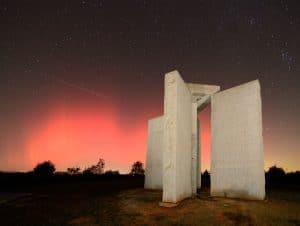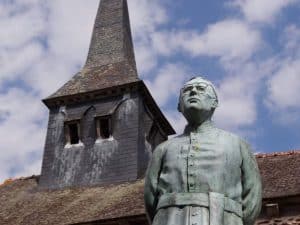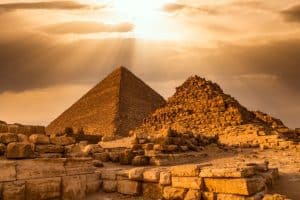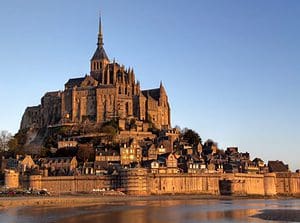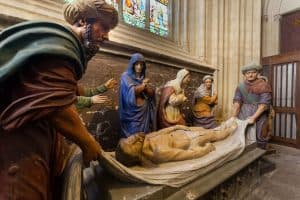The Ark of the Covenant must be among the most remarkable objects in history.
It could produce storms, emit supernatural fire, demolish city walls, destroy chariots, and wipe out entire armies. Furthermore, it could manifest God’s voice and presence.
The Ark of the Covenant in the Bible
In more than 40 different stories, there are almost 200 unique references to the Ark of the Covenant up to the reign of Solomon (970-931 BC); following that, it is practically never mentioned again.
The ark is only mentioned twice in the New Testament, in the Book of Revelations and in the letter to the Hebrews (9:3-4), where Paul discusses the Tabernacle en tells us what was inside the ark:
“Behind the second curtain was a room called the Most Holy Place, containing the golden altar of incense and the gold-covered ark of the covenant. Inside the ark were the gold jar of manna, Aaron’s staff that had budded, and the stone tablets of the covenant.“
If you would like to find al the references for yourself, you can use the online King James Bible to search for the “Ark of the Covenant” or the “Ark of the testimony”.
What is the Ark of the Covenant?
The Bible is very clear about the Ark of the Covenant and what it represents. The Ark was given to Moses by God himself, and it was to be used as a sign of God’s covenant with the Israelites.
The Ark was a physical embodiment of God’s presence among his people, and it was to be treated with the utmost respect and reverence. Anyone who dared to touch the Ark or look inside it would be severely punished by God.
What did the ark of the covenant look like?
The Ark of the Covenant was first mentioned in the Bible in the book of Exodus, when Moses was given instructions on how to build it. About a year after their departure from Egypt, the Israelites were camped at the base of Mount Sinai (Mount Horeb).
In accordance with God’s instructions, Moses ascended the mountain and was given two stone tablets (slabs) containing the Ten Commandments by God.
However, after returning from the Sinai, Moses smashed the two tablets to pieces when he saw how the people of Israel had made a golden calf to worship it. After this, God instructed Moses (Exodus 34) to write down the commandments on two new slabs of stone.
Finally, God gave orders to build an ark (chest) to contain the text of the covenant.
The Book of Exodus (25:10-23) is very specific about what the Ark should look like:
2.5 cubits long, 1.5 cubits wide, and 1.5 cubits high and built of acacia wood. According to archeology, the average length of the common cubit is 44.5 cm (1.5 feet).
The completed chest was completely gilded with gold.
Four gold rings are to be affixed to its four corners, two on each side, and staves of acacia wood plated with gold for transporting the Ark are to be placed through these rings. The staves are never to be removed.
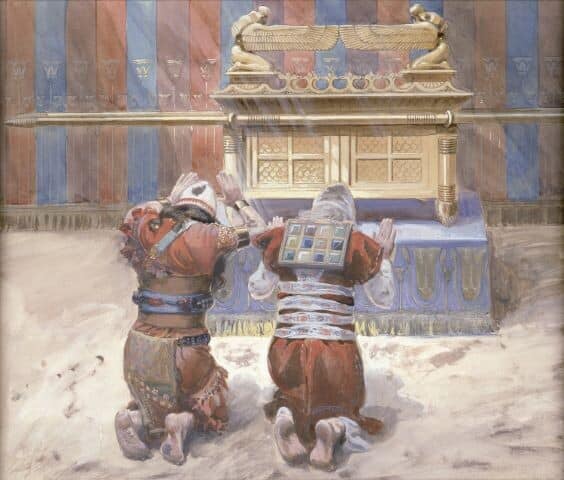
The kapporet (translated as “mercy seat” or “cover”) was a golden lid adorned with two golden cherubim (angels) facing each other.
The Bible states that after its construction, the Ark was carried by the Israelites during their 40 years of wandering in the desert. The Ark was kept in the Tabernacle, a holy tent.
What was the ark of the covenant used for?
The cover or “mercy seat” was considered as the throne of God and during the journey from the Israelites through the desert, God used it to speak to Moses.
The ark was the most important and sacred object of the Jews. On the annual Great Day of Atonement, blood was sprinkled on this mercy seat by the high priest.
The Ark of the Covenant helped the Israelites when they arrived in the promised land.
When the Israelites arrived at the banks of the River Jordan, the Ark was carried in the lead. The river dried up as soon as the priests stepped into the water, and the Jordan stayed dry until all the people had crossed.
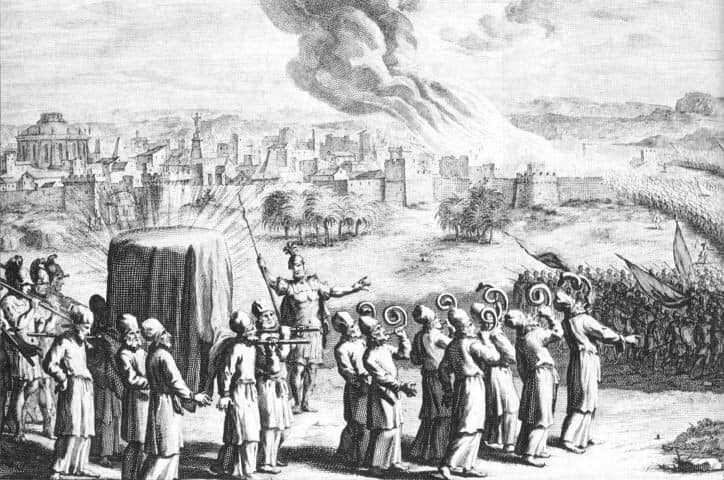
When the Israelites finally arrived in the Holy Land, the Ark was used in the Battle of Jericho. It was carried around the city once every day for six days, accompanied by armed soldiers and seven priests blowing rams’ horn trumpets. On the seventh day, the seven priests blew the seven horns seven times, and with a great cry, Jericho’s wall collapsed. The Israelites captured the city.
But the Ark of Covenant did not always provide victory.
In 1 Samuel 4,5 we read the Israelites were defeated in the battle of Eben-Ezer. Following this defeat, the elders of Israel agreed to carry the Ark onto the battlefield to aid them against the Philistines.
They suffered another crushing defeat, losing 30,000 troops.
The Philistines took the Ark with them. However, everywhere the ark was housed, there were disasters. People were afflicted with tumors and hemorrhoids. There was also a mouse plague.
When the Ark was finally placed in the temple of Dagon at Ashdod, the statue of Dagon was discovered lying in front of the Ark. The statue of Dagon was returned to its place, but the following morning it was discovered lying on the ground once again, this time with its head and hands chopped off.
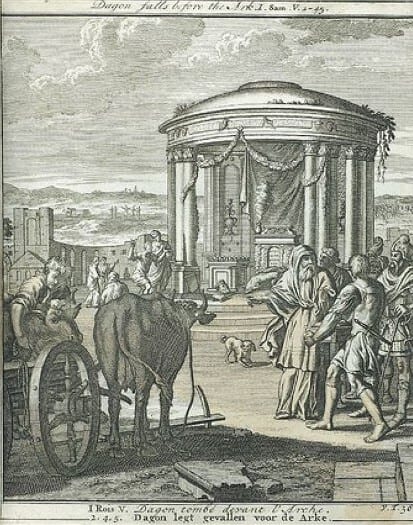
Finally, the Philistines presented a sacrifice consisting of five golden tumors and five golden mice. They then placed the gifts and the ark on a cart driven by two milk cows, which headed directly for Israel, to Kirjath-Jearim.
The story of Uzzah
2 Samuel 6:1–7 and 1 Chronicles 13:9–12 tell the account of Uzzah and the Ark of the Covenant. At the start of his reign, King David joyfully took the Ark from Kirjath-jearim.
As the ark was being transported, the oxen dragging the cart began to stumble, and a man called Uzzah grabbed hold of it. God’s wrath flared toward Uzzah, and He killed him.
The building of the temple
David placed the Ark in the tent he had built for it in Zion, performed sacrifices, distributed food, and blessed both the people and his household. David utilized the tent as his own place of worship. He wanted to build a temple for the ark, but was not allowed to do so. God wanted a man of peace to construct the temple, not a man of war. Therefore, the building of the temple was passed on to David’s son and successor, Solomon.
The Books of Kings include a detailed account of the construction of the temple by Solomon, who put the Ark in the Holy of Holies, the temple’s windowless inner sanctuary.

Only the High Priest of Israel, bearing the blood of a sacrificed lamb and burning incense, entered the temple once a year on Yom Kippur, the day of Atonement.
In addition to serving as a place of prayer, the Temple also acted as a gathering place for the Israelites. It seems the ark was kept safely in the temple until 587 BC.
In 587 BC, the Babylonians destroyed Jerusalem and Solomon’s Temple. In the Books of Kings and in the Chronicles, there is no mention of what happened to the Ark.
However, an ancient Greek version of the biblical third Book of Ezra, 1 Esdras, claims that Babylonians carried away the vessels of the ark of God, but the Ark is not specifically mentioned:
“And they took all the holy vessels of the Lord, both great and small, with the vessels of the ark of God, and the king’s treasures, and carried them away into Babylon.”
The ark mentioned in the book of Maccabees
The book of the Maccabees are considered canonical. According to 2 Maccabees 2:4-10 the prophet Jeremiah took the Ark, Tabernacle, and Altar of Incense and buried them in a cave. He informed his followers that the location should remain unknown “until the time that God should gather His people again together, and receive them unto mercy.”
The ark of the covenant mentioned in the Treatise of the Vessels
A newly translated Hebrew manuscript called the Treatise of the Vessels (Massekhet Kelim) claims to reveal the whereabouts of the treasures from King Solomon’s temple as well as the fate of the Ark of the Covenant.
The “treasures were buried by a number of Levites and prophets,” wrote James Davila, a professor at the University of St. Andrews, who translated the manuscript in 2013.

The “Emek Halachah,” a book that was published in Amsterdam in 1648, contained the first known example of this manuscript. Another edition, released in 1876 by a researcher by the name of Adolph Jellinek, was nearly identical to the 1648 edition.
The book resembles the metallic “Copper Scroll” one of the Dead Sea Scrolls discovered in 1947 close to Qumran in the West Bank. The Copper Scroll also talks about hidden treasures.
The author probably wasn’t trying to tell where the hidden treasures of Solomon’s Temple are located. Instead, he was basically writing a work of fiction based on different legends.
According to the text, the treasures were “buried in different sites in the Land of Israel and in Babylonia, while others were transferred into the hands of the angels Shamshiel, Michael, Gabriel, and maybe Sariel” and “they shall not be revealed until the day of the coming of the Messiah son of David.”
The ark of the covenant mentioned in prophecies
The idea that the ark will not be revealed until the day of the coming of the Messiah, is also written in the New Testament. The book of revelation is the last bible book and is dedicated to the return of Christ.
After the seventh trumpet sounded “the temple of God was opened in heaven, and there was seen in his temple the ark of his testament: and there were lightnings, and voices, and thunderings, and an earthquake, and great hail”. (rev. 11:19)
Researchers and the Ark of the Covenant
The fact that the most sacred item in Jewish history merely disappeared is fascinating. It is odd that it receives so little attention in the bible following the completion of Solomon’s temple.
Only a few canonical works discuss what happened to it after the invasion of Babylon, but the point is made: The ark won’t be found again until the Messiah comes back.
All of this does not change the fact that several researchers have been looking for the ark’s location throughout history.
A few options:
Ethiopia
According to Graham Hancock, the ark can be found in Aksum, Ethiopia.
Source: The Sign and Seal: The Search for the Lost Ark of the Covenant by Graham Hancock, Simon & Schuster, 1992.
England
Graham Phillips provides evidence that the Ark may be located in the English countryside, not far from the birthplace of William Shakespeare at Stratford-upon-Avon.
Source: The Templars and the Ark of the Covenant, Graham Philips
Jerusalem
Ron Wyatt claimed he found the Ark of the Covenant at Golgotha, where Jesus was crucified.
America
In “America Unearthed,” host Scott Wolter uses hard science and intuitive theories to explain the most mysterious artifacts and sites in America. According to him, the ark is located in Arizona.
(Only available in the United States)


